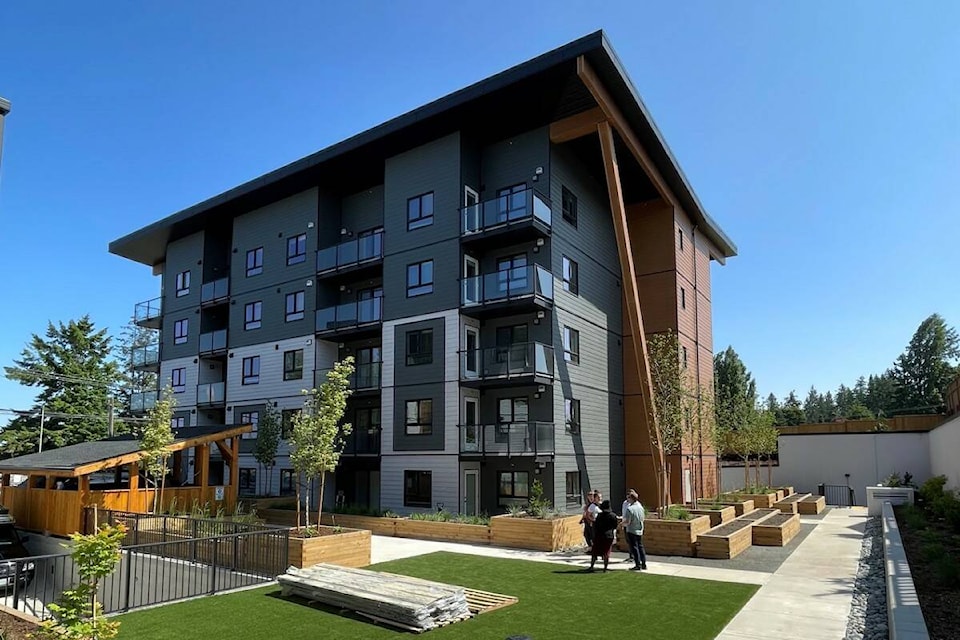Central Saanich’s first supportive housing project – the Aurora – is now three-quarters of the way full and is working to integrate into the community following years of construction-related delays.
Owned by BC Housing and operated by Pacifica Housing, the 38-unit development on Prosser Road has been the subject of controversy since it was announced more than three years ago.
To promote conversation and address concerns from members of the community, Pacifica Housing will be forming a community advisory committee that is scheduled to meet for the first time next week.
Committee members will include a representative from Central Saanich police, Island Health, BC Housing, Pacifica Housing, city manager Christine Culham on behalf of the District of Central Saanich, three neighbours from the community and other community parties.
“It will be an opportunity to discuss questions, concerns, suggestions about the building and just making sure that we can, together, help integrate the residents into that community,” said Carolina Ibarra, CEO of Pacifica Housing.
The site footprint is shared with an affordable housing project owned by the CRD and operated by the Capital Regional Housing Corporation that opened June 1 and is now almost fully occupied.
Community integration was the non-profit’s first priority since becoming the operator of the Aurora in December 2022. Ibarra said Pacifica has spent the last seven months connecting with the community and council about the plans for the site.
Since the building started welcoming residents in late May, Ibarra said she is “not aware of any concerns from neighbours … or any anomalies that have occurred in the building.” She added she asks for neighbours’ patience in the next few months as residents settle in.
“When people move in from homelessness or precarious housing and they haven’t been connected to health services, it does take time for them to settle,” she said. “We’re expecting that there are going to be some ups and downs in the next few months while the community forms.”
In 2021, Central Saanich Couns. Paltiel and Bob Thompson co-sponsored a motion requesting that preferential selection be given to stabilized individuals working on achieving employment, local and First Nations residents, as well as seniors.
“I think the best thing we can do right now as a community is to keep an open mind and work at being good neighbours. That positive introduction is going to be the most important thing we can do to find success and good relationships on both sides,” Paltiel said.
Pointing to the ongoing overnight closures of the Saanich Peninsula Hospital ER as an example, Paltiel said it was important to recognize the district’s currently strained capacity for those in need of immediate and significant care when selecting residents.
“It’s not about being exclusive to folks in need, it’s being realistic about our own resources as a municipality,” Paltiel said. “If we want to give everyone a fair shake and set people up for success, being aware of the current resources and amenities we have available for us as a community is really important.”
Acknowledging these commitments to the community, Ibarra said Pacifica Housing carefully selected the building’s residents.
Paltiel said it was reassuring to hear that more than 70 per cent of residents are either from the peninsula or from a local First Nations community.
“I think that piece has really struck a chord with the neighbours that I’ve spoken to,” he said.
The Aurora has a “more intensive focus beyond stabilization to independence,” and includes a life skills worker who supports residents in developing skills such as budgeting, cooking, cleaning and connecting with community resources.
Island Health’s mobile primary care team also visits the site once per week. Ibarra said this model will address previous concerns about proximity to adequate health care and addiction services, adding the mobile model will not draw on community resources.
“Those primary care visits make all the difference in the world because it’s rare that our clients would have a family doctor, and most of them would be quite weary of the health care system,” she said. “Having primary health go to visit them on a schedule alleviates a lot of these situations that cause people to go to the emergency room.”
Pacifica hosted an open house in early June to engage with the community and Ibarra said she was happy with the response.
“Despite the opposition and how people were angry, I’m really grateful that people showed up, engaged, asked questions and expressed their frustration because that’s how we can understand and communicate and clarify,” she said.
“It says a lot about the Central Saanich community. They really care about their community, they want to learn about it and they want to learn and engage constructively, which is really great.”
READ MORE: Victoria backyard deck hearing wastes council’s time amid crisis: councillor



